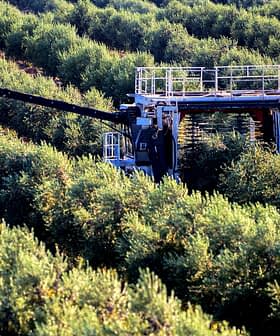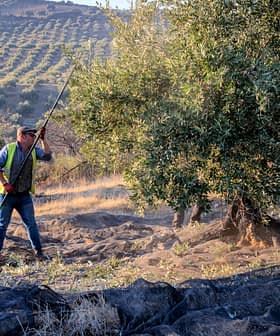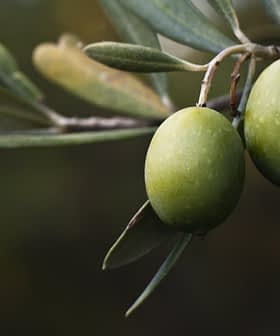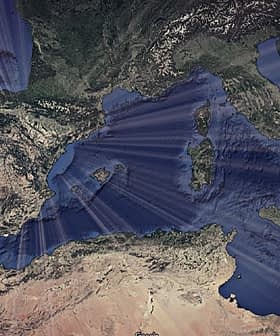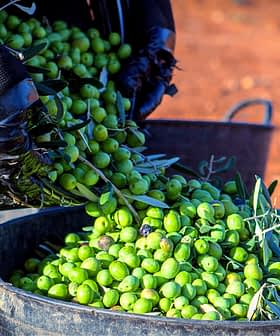Researchers Study How Lack of Chill Hours Impacts Olive Development, Oil Quality
The lack of chill hours has resulted in longer flowering periods, more oil accumulation and distinct oil chemistry in olives grown in the subtropical climate of Tenerife.
 Guacimara Medina (left) in Tenerife (Photo: Lorenzo León)
Guacimara Medina (left) in Tenerife (Photo: Lorenzo León)  8.0K reads
8.0K readsResearchers are studying how rising temperatures are affecting olive trees in Andalusia and the Canary Islands, with the goal of determining which olive varieties are best suited for future climate conditions. The study has found that olives grown in the Canary Islands have longer flowering periods, higher oil accumulation, and a different polyphenol profile compared to those grown in Andalusia, but also face challenges in terms of pest susceptibility and oil quality due to the warmer climate. Further research is needed to determine the best olive varieties for future climate scenarios.
Rising annual average temperatures across much of the olive-growing world have created uncertainty that olive trees will receive the necessary 200 to 600 chill hours between 2 ºC and 10 ºC required to enable vernalization.
Researchers from the Andalusian Institute of Agricultural, Fisheries, Food and Organic Production Research and Training (IFAPA) and the Canary Islands are working on an ongoing study to determine which of the world’s most popular olive varieties may be best prepared for rising winter temperatures in the most productive olive oil-producing region on Earth.
The theoretical models… forecast that when there is no winter chill, the olive will not flower. But when we went to the Canary Islands, we found that what actually happens when there is no winter chill is very different.
“We are very worried about climate change, and there were a lot of papers or models forecasting what will happen with climate change in the future in the Mediterranean with olives,” Raúl de la Rosa, a senior researcher at IFAPA, told Olive Oil Times.
“However, all the models were based on theoretical assumption, and no practical trials had been done about what happens when you plant olive trees in a place where there is no winter,” he added.
See Also:Experiment with North African Olive Varieties Bears Fruit in CroatiaOn the island of Tenerife, the largest and most populous of the Canary Islands, commercial olive growing began in 2005.
According to data from Aemet, the state-run meteorological agency, average winter temperatures on the arable parts of the island range from 12.5 ºC to 17.5 ºC, with average daily lows between 10 ºC and 12.5 ºC. In Andalusia, average winter temperatures generally sit within the 2 ºC to 10 ºC window.
Some climate models predict that the current warming trend will result in Andalusia’s winter temperatures more closely matching those of the Canary Islands in the next 30 years.
Over the past six years, the IFAPA researchers and their local partners planted Picual, Hojiblanca, Cornicabra, Arbequina, Coratina, Korneiki and Martina – a cross of Picual (also known as Marteño) and Arbequina – near Córdoba and Málaga, in Andalusia, and on Tenerife.
Each of the three grove locations has markedly different climates, with the groves near Málaga experiencing slightly higher average winter temperatures than those in Córdoba.
This helped the researchers determine that temperature was causing the main differences between olive development in Tenerife and Córdoba instead of other factors such as soil composition.
Since the study began, the researchers have observed several marked differences in how olives behave in Tenerife compared to Andalusia, with the most noticeable differences involving the olive tree flowering period, oil accumulation and chemical composition.
“The theoretical models that were produced here in the peninsula forecast that when there is no winter chill, the olive will not flower,” de la Rosa said. “But when we went to the Canary Islands, we found that what actually happens when there is no winter chill is very different.”
Instead, Guacimara Medina, an agricultural extension technician and Ph.D. researcher involved in the study, told Olive Oil Times that olives planted in the Canary Islands have two flowering periods from January to May.
“When there’s no winter chill, the olive trees always flower, but for much longer than in Andalusia, and there are several flowering periods from January to May,” she said. “The flowering period is longer, and the olive trees flower for three months, sometimes more.”
As a result of the extended flowering periods and their non-endemic nature on Tenerife, Medina added that the trees were increasingly susceptible to damage from pests, requiring more intensive phytosanitary intervention.
See Also:Climate Change Taking a Toll on Andalusian Olive Oil ProductionAlong with the flowering period, Medina said that oil accumulation was much higher in olives grown on the island.
“Due to the mild temperatures, the oil accumulation doesn’t stop,” she said. “In Mediterranean conditions, the oil accommodation finishes when the temperatures decrease.”
However, Tenerife’s subtropical climate means that oil accumulation can reach up to 60 percent, compared to 20 percent in the most efficient varieties in Andalusia.
Early flowering and the continued oil accumulation also mean many olives are ready to be harvested by the end of July or early August in the Canary Islands, making it the first palace to produce olive oil each crop year in the European Union.
As a result, Medina said that local producers on the island are seeking a protected geographical certification, such as a Protected Designation of Origin (PDO) or Protected Geographical Indication (PGI), to help promote the island’s oils.
In terms of chemical composition, Medina said olives grown on Tenerife have a distinct polyphenol profile compared to their counterparts in Andalusia.
“The polyphenols are different and higher than in Andalusia,” she said. Specifically, there are more tocopherols, an organic chemical compound with vitamin E activity, in Canarian oils than in Andalusian oils.
However, higher year-round temperatures also significantly lower the margin for error during the transformation process to ensure that all the oil yielded meets the extra virgin olive oil standards.
De la Rosa said other studies have shown that when oil accumulation in Arbequina olives happens at higher temperatures, oleic acid concentrations decrease while linoleic acid concentrations rise.
“So the stability of the oil is very low,” he said. “This is a big problem. In the future, if the oil accumulation occurs at a higher temperature, it will negatively affect the olive quality.”
“Our job is to look for cultivars with the genetically higher stability of the oil,” he added.
For example, de la Rosa said Martina – the cross between Picual and Arbequina – has shown promise. “So maybe in a future climate scenario, we will use mainly cultivars like those,” he said.
However, the research trials – the most recent of which started six months ago – must continue before concrete conclusions can be reached.
Share this article


